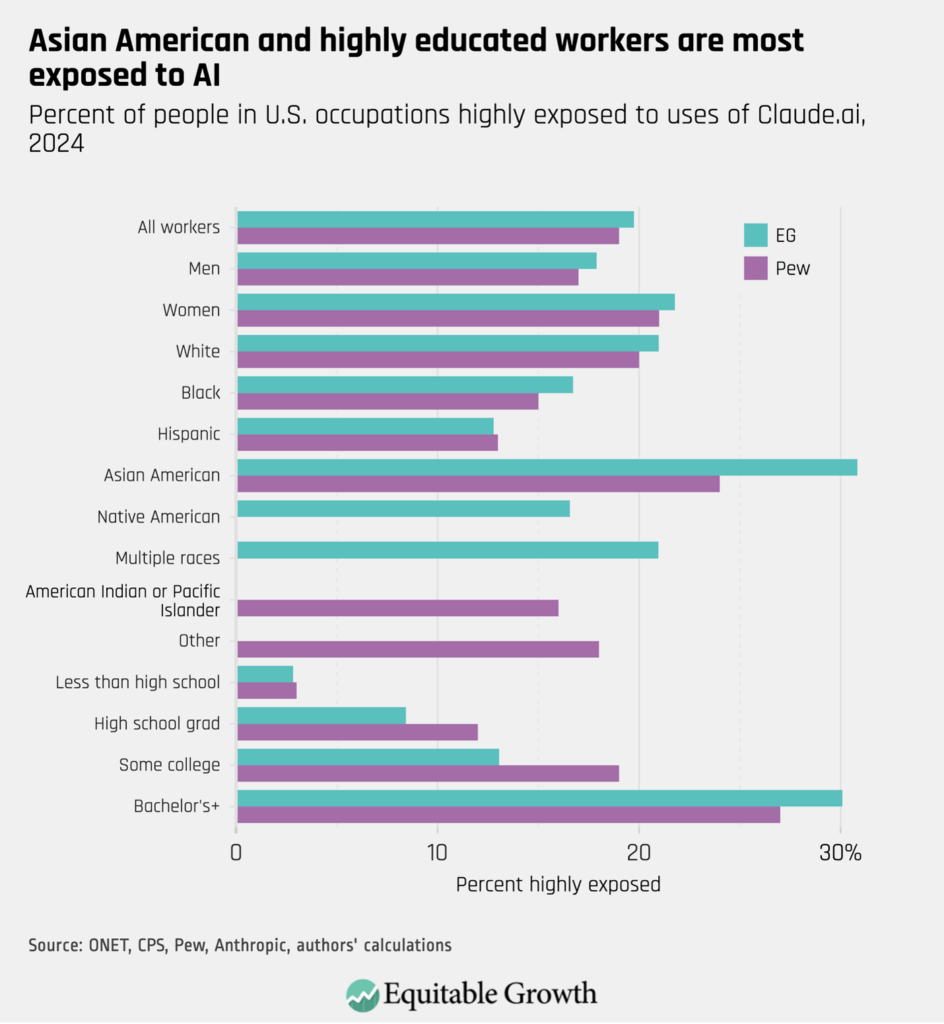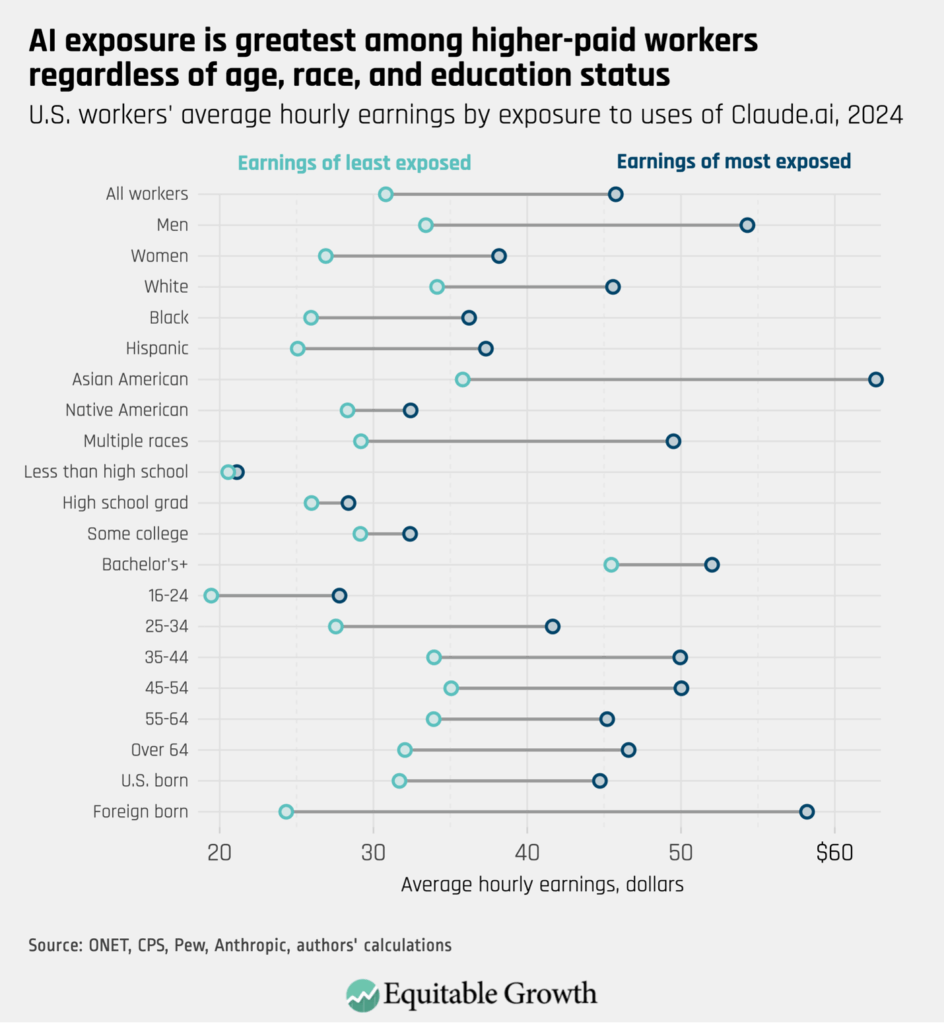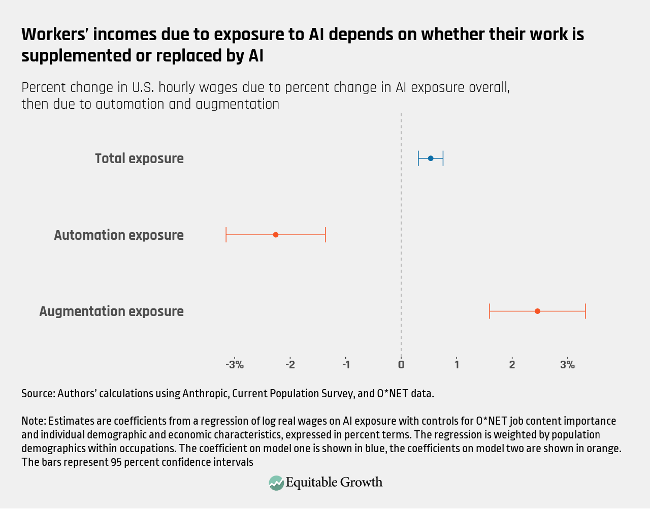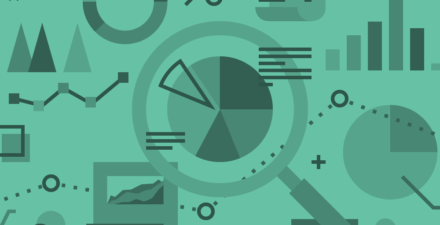Workplace exposure to artificial intelligence is higher among U.S. workers with higher wages, depending on how AI is used

Overview
Recent advances using artificial intelligence in workplaces, particularly large language models such as Claude.ai and ChatGPT, are increasingly disrupting the U.S. labor market. The cognitive power of AI has the potential to enhance the productivity of some workers while automating other tasks. But how the progression of AI in the workplace plays out across different occupations and affects the earnings of U.S. workers is still hard to pinpoint with precision.
In our new working paper, we measure U.S. workers’ exposure to AI and assess how it may affect their wages. Our analysis builds on previous work by the Pew Research Center and the AI firm Anthropic, as well as Equitable Growth’s own job-quality series. We confirm that exposure to AI is higher among people with higher levels of education who work in high-paying jobs, regardless of gender or race. We also find that AI’s effect on incomes, while overall marginally positive, is contingent on how it is used in workplaces to either augment or automate jobs.
Calculating U.S. workers’ exposure to AI
In July 2023, the Pew Research Center published its paper on AI exposure. Pew’s methodology was largely qualitative, with the researchers using their “collective judgment” to predict AI exposure by occupation. Then, in February 2025, the AI firm Anthropic published its findings on worker exposure to AI by occupation as a part of its “Economic Index,” along with a corresponding paper. By analyzing trends in conversations with their chatbot, Claude.ai, the Anthropic researchers measured the frequency at which certain tasks are augmented (supported) or automated (replaced) by the use of AI.
Both Pew and Anthropic utilized the worker task hierarchy supplied by the U.S. Department of Labor’s Occupational Information Network, or O*NET, as the primary framework for their analyses. These metrics are useful for understanding the content of jobs and are the basis for Equitable Growth’s series on job characteristics and job quality in the United States.
Anthropic linked queries made to Claude.ai to one of several thousand O*NET tasks, or functions performed by a worker in the course of doing a particular job. They then measured the frequency with which these tasks are associated with Claude.ai conversations. The worker task “design or develop automated testing tools,” for example, occurs in 15.7 percent of Claude.ai queries in the sample, 8.8 percent of which describe automative behavior and 6.9 percent of which describe augmentative behavior.
In our analysis, we also calculate AI exposure by occupation using these publicly available task-level metrics. We additionally source task frequency data from O*NET and then weight each task by how often it is performed on average in its corresponding occupation. Once we determine overall exposure for O*NET occupations, we then match AI exposure metrics to the U.S. Census Bureau’s list of occupations. We used these data to produce figures comparable to those in the original Pew paper, confirming greater AI exposure in the workplace among women versus men, Asian Americans versus other racial and ethnic groups, and highly educated workers. (See Figure 1.)
Figure 1

We additionally confirm the Pew finding that workers with higher incomes tend to be more exposed to AI, regardless of race, age, citizenship status, and education. (See Figure 2.)
Figure 2

The relationship between AI exposure and workers’ incomes
We find that exposure to AI in workplaces has a statistically significant and positive but minor effect on workers’ hourly wages.This may be due to more profound but opposing influences of different types of AI and their applications. Whether artificial intelligence improves or undermines workers’ incomes is therefore largely determined by whether AI supports or replaces the tasks they perform.
More specifically, we calculate the percent change in hourly wages given a percent change in exposure to AI. (See Figure 3.)
Figure 3

All else held equal, a percent increase in total AI exposure will, on average, predict an 0.5 percent increase in hourly wages. But, as seen in Figure 3 above, this relatively minimal overall effect of AI exposure on wages may conceal the larger effects of augmentation-driven or automation-driven AI use. When considered on its own, exposure to automative AI reduces wages by 2.3 percent, but this effect is simultaneously counteracted by augmentative AI exposure, which increases wages by 2.5 percent for every 1 percent increase in AI exposure.
These results are telling. Artificial Intelligence has the potential to improve some workers’ wages if it helps them do their jobs more effectively and efficiently. But AI is equally likely to reduce workers’ wages in areas where it can substitute for workers.
Conclusion
U.S. workers’ exposure to artificial intelligence, measured in terms of uses of Anthropic’s Claude.ai agent, has a still-ambiguous relationship with workers’ incomes. Different occupations’ exposure to the augmentative use of AI is positively correlated with higher wages, while exposure to its automative use is negatively correlated. Overall exposure is slightly positively correlated with earnings.
Corroborating earlier work from the Pew Research Center, we find meaningful differences in AI exposure along lines of gender, race, education, and income. Women tend to work more in highly exposed occupations compared to men, a relationship that holds across most racial groups. Workers with college educations and high incomes also tend to work in highly exposed occupations, trends that are persistent across race. White and Asian American workers overall tend to work more in highly exposed occupations, compared to Black and Hispanic workers.
Our new working paper advances the growing body of research on the continuing impacts of artificial intelligence on the U.S. labor market and suggests avenues for future exploration. Different types of AI use are likely to be deployed to differing effects, with some uses assisting human workers and other uses displacing human work altogether. Policymakers should be cognizant of these differences when regulating the development and workplace deployment of artificial intelligence.
Did you find this content informative and engaging?
Get updates and stay in tune with U.S. economic inequality and growth!







Stay updated on our latest research